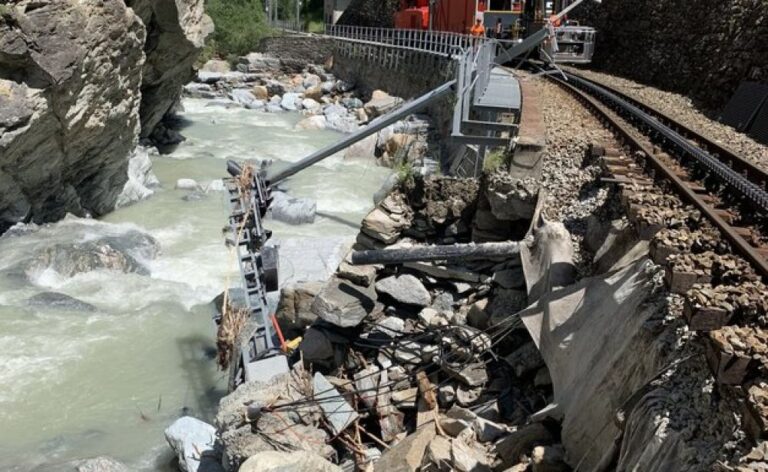### Following Catastrophic Flooding in Switzerland: The Impact of the Zermatt Rail Link Shutdown
Switzerland is renowned for its stunning landscapes, charming villages, and efficient transportation systems. However, the recent catastrophic flooding that affected the region, particularly Zermatt, has exposed vulnerabilities in even the most resilient areas. With the Zermatt rail link shut down for weeks, the impact on the community, tourism, and the broader Swiss economy has been profound.
#### The Severity of the Flooding
In late summer 2023, intense rainfall caused rivers to overflow, leading to significant flooding across parts of Switzerland. Zermatt, a beloved tourist destination nestled at the foot of the Matterhorn, was particularly hard-hit. The torrential downpours transformed the usually serene landscape into a scene of chaos, with mudslides and swollen rivers posing immediate threats to infrastructure and safety.
Emergency services worked tirelessly to rescue stranded residents and tourists, while roadways and rail lines became impassable. The Zermatt rail link, a vital transportation artery connecting the village to the rest of the country, was severely damaged, effectively isolating Zermatt from the outside world.
#### The Impact on Transportation
The Zermatt rail link, part of the Glacier Express route, is essential not only for locals but also for the millions of tourists who flock to Zermatt each year. With the rail service suspended, alternative transportation methods were quickly overwhelmed. Local buses and taxis were unable to accommodate the influx of travelers trying to exit the area or return home, leading to frustration and confusion.
The railway closure also disrupted supply chains, making it difficult for businesses to receive essential goods, food, and materials. As the isolation continued, the economic impact became increasingly apparent, with local shops and restaurants struggling to stay afloat amid dwindling customer numbers.
#### Economic Consequences for Zermatt
Zermatt’s economy heavily relies on tourism, with visitors drawn to its breathtaking scenery, skiing opportunities, and vibrant culture. The prolonged closure of the rail link had immediate financial ramifications. Hotels reported cancellations at an alarming rate, with many guests unable to access the village due to the transportation shutdown. This was particularly concerning during the peak summer season when tourism typically flourishes.
The loss of revenue was felt not just by hotels but also by local businesses, from souvenir shops to restaurants, which depend on a steady stream of visitors. Many faced the grim reality of laying off staff or even shutting down temporarily, threatening the livelihood of residents who had built their lives around the tourism industry.
#### Community Resilience
In the face of adversity, the community in Zermatt demonstrated remarkable resilience. Residents banded together to support one another, sharing resources and information about safety measures. Local organizations initiated efforts to assist those affected by the flooding, distributing food and supplies to those in need.
Moreover, the local government and emergency services mobilized quickly to address the situation, conducting assessments and planning for recovery efforts. Community meetings were held to keep residents informed and engaged, fostering a sense of solidarity amid the crisis.
#### Restoration and Recovery Efforts
As the floodwaters receded, attention turned to restoration. Engineers and construction crews worked around the clock to repair the damaged rail infrastructure. Assessments revealed significant structural damage, requiring careful planning and execution to ensure the safety of future operations.
The Swiss Federal Railways (SBB) coordinated with local authorities to expedite the repair process, recognizing the urgency of restoring access to Zermatt. While repairs were ongoing, alternative transport solutions were explored, including temporary bus routes and shuttle services, to help mitigate the impact of the rail shutdown.
#### The Role of Tourism in Recovery
As the rail link neared reopening, tourism officials began preparing for the eventual influx of visitors. Marketing campaigns were launched to promote Zermatt as a resilient destination, emphasizing the community’s strength and commitment to recovery. The focus was on attracting tourists back to the region while ensuring they were aware of the improvements and safety measures in place.
Local businesses also rallied to create special offers and packages aimed at encouraging visitors to return. The message was clear: Zermatt was ready to welcome back travelers, showcasing its natural beauty and rich culture despite the challenges faced.
#### Lessons Learned
The flooding in Zermatt highlighted the importance of disaster preparedness and resilience planning. As climate change increases the frequency and severity of extreme weather events, communities must prioritize infrastructure upgrades and emergency response strategies. Investing in robust drainage systems, early warning systems, and community training can help mitigate future impacts.
Additionally, the event served as a reminder of the interconnectedness of local economies and transportation systems. A disruption in one area can have cascading effects, emphasizing the need for comprehensive planning and collaboration among various sectors.
#### Conclusion
The catastrophic flooding in Switzerland and the subsequent shutdown of the Zermatt rail link presented significant challenges for the community and the tourism industry. However, the resilience of the residents, combined with coordinated recovery efforts, has laid the groundwork for a hopeful future. As Zermatt emerges from this crisis, it stands as a testament to the strength of community and the enduring appeal of this remarkable destination. The reopening of the rail link will not only restore access but also symbolize the triumph of a community that faced adversity head-on, ready to welcome the world once again.


